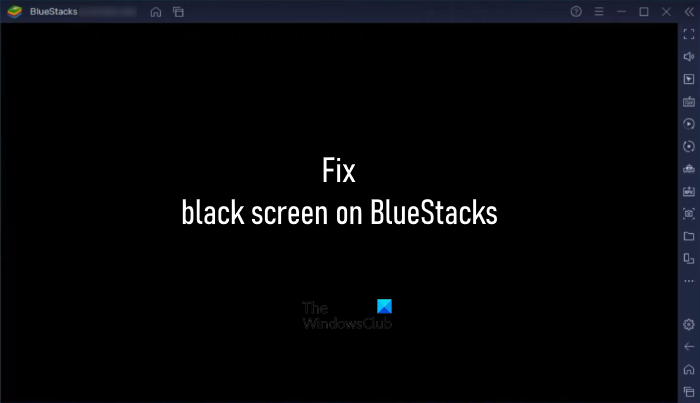In this article, we will see how to fix black screen on BlueStacks on Windows 11/10. BlueStacks is an Android emulator for Windows users that lets them play Android games and run Android apps on their Windows computers. Some users reported that a black screen appears after launching the Android apps or games on BlueStacks, whereas, for some users, the black screen appears just after starting the BlueStacks Player. If you are experiencing such an issue with BlueStacks, use the solutions provided in this article.

How to fix Black Screen on BlueStacks on Windows 11/10
Use the following solutions to fix black screen on BlueStacks on Windows 11/10:
- Update your graphics card driver
- Change graphics settings in BlueStacks
- Change graphics settings to High Performance for BlueStacks
- Uninstall and reinstall the Android app or game
- Create a new instance in BlueStacks
- Change the display resolution in BlueStacks settings
- Uninstall and reinstall BlueStacks
Below, we have explained all these fixes in detail.
1] Update your graphics card driver
You are experiencing a black screen on BlueStacks which is a display-related issue. One possible cause of the display problems on a Windows computer is the corrupted or outdated graphics card driver. We suggest you check for updates for your graphics card driver and install the update (if available).
To do so, visit the official website of your graphics card manufacturer. Check for the updates by entering your graphics card model name. Some websites have an auto-detect feature. You can also use it to let your graphics card be detected automatically.
2] Change graphics settings in BlueStacks
If updating the graphics card driver does not help, change the graphics settings in BlueStacks and see if it helps. When we install BlueStacks, a BlueStacks Multi-instance Manager is also installed automatically. The BlueStacks Multi-instance Manager allows users to create and manage multiple instances of BlueStacks on their system.
Because the screen is not visible to you, you have to use this Multi-Instance Manager to change the graphics settings in BlueStacks. Follow the steps written below:
- Open BlueStacks Multi-instance Manager.
- You will see all the instances that you have created on BlueStacks. Now, click on the Settings icon next to the BlueStacks instance you are experiencing issues with.
- Select the Graphics tab from the left side.
- Click on the Interface renderer drop-down menu and select another option.
- Click Save Changes.
Now, launch BlueStacks and see if the black screen issue is fixed or not. For some users, the OpenGL option worked. First, you can go with the OpenGL option. If it does not work, you can try other options.
3] Change graphics settings to High Performance for BlueStacks
We also suggest you check which graphics setting is selected in Windows 11/10 for BkueStacks. Go through the following instructions:
- Open the Settings app.
- Go to “System > Display > Graphics.”
- Select the BlueStacks or BlueStacks Player app and click Options.
- The Graphics preference should be set to the High performance mode. If not, change it.
Now, launch BlueStacks. This should work.
4] Uninstall and reinstall the Android app or game
If the black screen issue is occurring on some particular Android apps or games, the issue may be associated with that particular app or game. In this case, uninstalling and reinstalling the app or game resolves the issue. Uninstall the Android app or game and then reinstall it from Google Play Store in BlueStacks.
5] Create a new instance in BlueStacks
Creating another instance is helpful if you are experiencing issues with BlueStacks. The steps to create a new instance in BlueStacks are written below:
- Open BlueStacks Multi-instance Manager.
- Click Instance on the bottom left side.
- Select Fresh Instance.
- Select an Android version from the drop-down and click Next.
After that, BlueStacks will download the required files from the internet. For some users, the Pie 64-bit instance did the trick. You can also try this instance and see if it resolves your issue or not.
6] Change the display resolution in BlueStacks settings
Changing the display resolution is one more solution to fix the black screen issue in BlueStacks. To do so, again, you require the BlueStacks Multi-instance Manager. Open your BlueStacks Player settings in the Multi-instance Manager and select the Display tab from the left side. Now, select a lower display resolution than what is selected. When you are done, click Save changes and launch BlueStacks to see if the issue is resolved.
7] Uninstall and reinstall BlueStacks
If none of the above fixes resolved your issue, uninstall and reinstall BlueStacks by downloading its latest version from its official website.
What is better than BlueStacks?
There are several factors that determine whether a user likes an application or not. For example, features of an app. Hence, different users have different opinions about an application. BlueStacks is the most popular Android emulator for Windows. However, if you do not like BlueStacks, you can install other free Android emulators for Windows and use them as BlueStacks alternatives. If you like other Android emulators more than BlueStacks, they will be better than BlueStacks for you.
Can I use BlueStacks without Hyper-V?
Yes, you can use BlueStacks without Hyper-V. For this, you have to disable Hyper-V on your Windows 11/10 computer via Windows Optional Features. If this does not work, create a new instance for BlueStacks by using the BlueStacks Multi-instance Manager. The Nougat 32-bit BlueStacks instance does not require Hyper-V. Hence, you can create this instance to use BlueStacks without Hyper-V.
